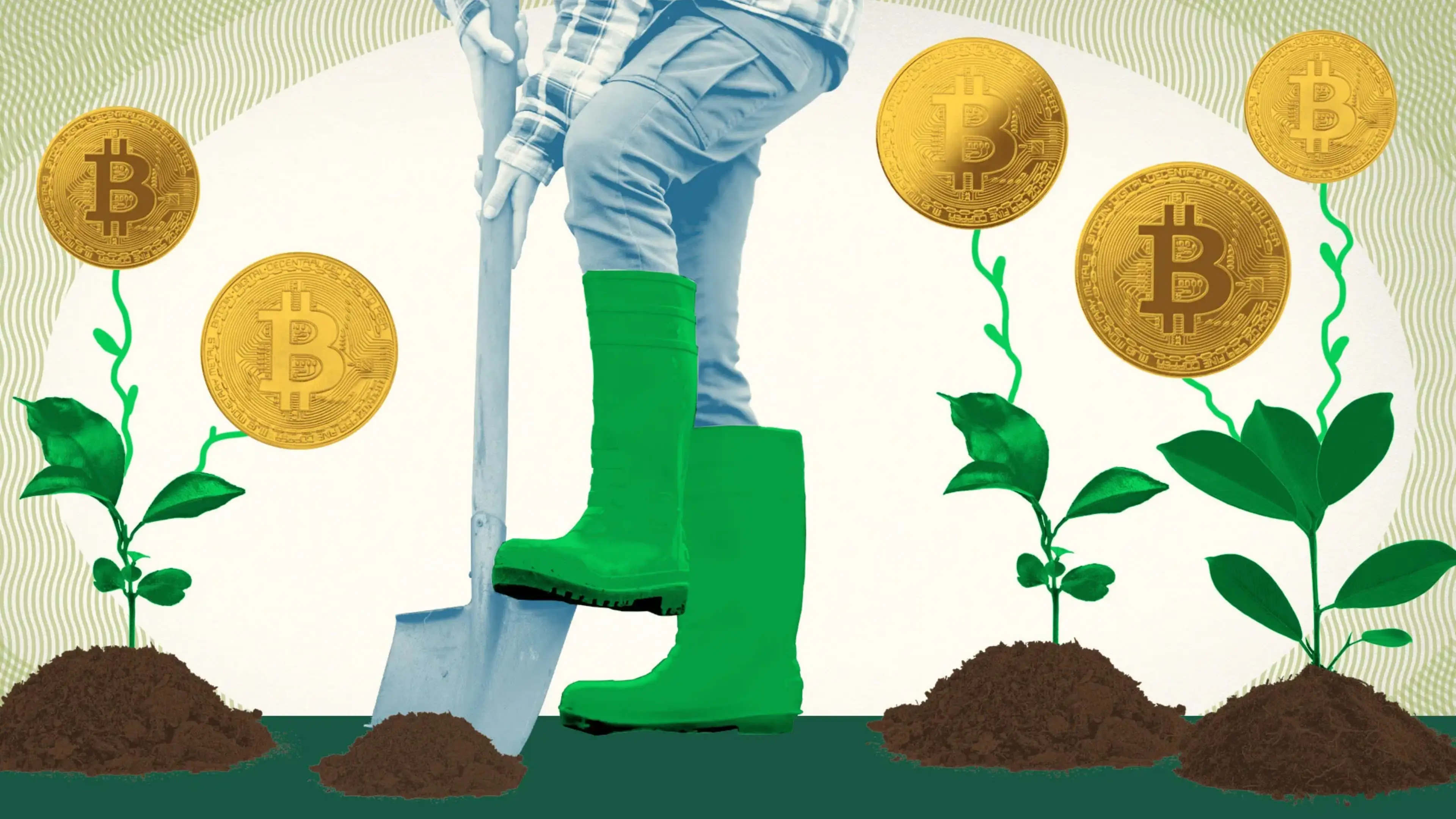
The world of decentralized finance, or DeFi, is a bustling, innovative frontier where crypto holders have discovered powerful new ways to put their digital assets to work. Two of the most prominent are crypto staking and yield farming. They're both powerful tools for earning passive income, yet they operate on distinct principles and come with a unique set of trade-offs. This guide will provide a comprehensive yield farming explained breakdown.
So, what is yield farming in crypto? And which is the right fit for your crypto farming ambitions? This guide will provide a side-by-side analysis of both staking and yeild farming, dissecting their core purposes, mechanics, and associated risk and reward profiles. By the end, you’ll have a clear understanding of which one aligns best with your goals, capital, and risk tolerance.
Key Takeaways
- Staking is a fundamental practice tied to the security and consensus of a blockchain. It’s like becoming a trusted citizen who helps keep the network safe and organized by locking up tokens. In return, you earn predictable, and often compounding, rewards. This is what sets it apart in the enduring staking vs mining debate.
- Yield farming, by contrast, is a dynamic and high-stakes strategy. It's focused on providing liquidity to DeFi protocols, acting as a financial alchemist. By depositing asset pairs into liquidity mining pools, participants earn rewards from a diverse range of sources, including trading fees and newly minted governance tokens. This is where the core difference between liquidity pools vs staking becomes crystal clear.
- The fundamental trade-off between these two strategies lies in risk versus reward and passivity versus activity. While staking provides a foundational, "set and forget" approach, a successful yield farmer must be a more speculative, hands-on participant, requiring deep technical understanding and constant vigilance.
What is Staking?

What exactly does staking mean in crypto? Imagine a blockchain network as a bustling digital city. Staking is the act of becoming a trusted validator who helps keep the city safe and organized. You stake crypto—or lock up your tokens—to a network that uses a Proof-of-Stake (PoS) consensus mechanism. In return for your help, you earn staking rewards.
This process is a pillar of network security. By committing your crypto, you get the right to participate in validating new transaction blocks. The more crypto you stake, the more "skin in the game" you have, which incentivizes you to act in the network's best interest. This helps protect the blockchain from potential attacks and ensures its integrity. It's a key part of the staking vs mining discussion in crypto.
The process of crypto staking begins with buying a cryptocurrency from a PoS protocol like Ethereum ($ETH), Solana ($SOL), or Cardano ($ADA). You then deposit these assets into a smart contract that acts as a secure, digital vault. Your rewards are distributed as newly minted tokens, which can often compound over time as they are added to your original stake. It's an easy way to earn passive income just by holding your assets.
How Staking Works
The way you stake depends on the amount of crypto you have and your technical knowledge.
- Validators: The most direct way to stake is by running a full validator node. This requires a significant capital investment—for example, the 32 $ETH needed to run an Ethereum validator. This approach gives you full control and all the rewards, but it also comes with the responsibility of managing the hardware and software. It's a method for experienced investors with a large amount of capital.
- Staking Pools: For most people, a staking pool is the way to go. This is an accessible alternative where you contribute your tokens to a pool managed by a third-party validator or service provider. In this model, you "delegate" your tokens to a validator who operates the node for you. While this method is much simpler, the intermediary may charge a fee for their service. This mechanism democratizes participation, allowing even small investors to earn rewards and access the benefits of staking pools crypto.
- Liquid Staking: A major issue with traditional staking is the lock-up period—a set time when your staked assets are inaccessible. Liquid staking solves this. When you stake tokens through a liquid staking protocol, you get a liquid staking token (LSD) in return, which is pegged 1:1 to your staked asset. You can then use this LSD in other DeFi applications—for trading, lending, or as collateral—while your original funds remain locked and earning rewards.
Benefits and Risks of Staking
The advantages of staking make it a popular choice for many crypto investors.
- Passive Income: Staking provides a way to earn steady passive income on your crypto holdings, similar to earning interest in a savings account. It's a popular high yield crypto staking option for many.
- Simplicity: For most users, it's a straightforward "set and forget" strategy that requires minimal ongoing management.
- Security: By staking, you actively contribute to the blockchain's security, helping to ensure its stability and integrity.
But staking isn't without its risks. The main staking risks include:
- Slashing: A key protocol risk is "slashing," where a portion of your staked funds is confiscated as a penalty for a validator's misbehavior or downtime.
- Lock-up Period: The lock-up period can be a significant risk. If the market suddenly dips, you can't sell your staked assets, which could lead to a greater loss than your staking rewards can offset.
- Market Volatility: The value of your rewards is tied to the price of the underlying token. If the token's price drops significantly, your total investment could lose value in dollar terms, even with a high annual yield.
What is Yield Farming? (Crypto Farming Explained)

Source: Encyclopaedia Britannica
If staking is about becoming a digital landlord, then yield farming is more akin to a financial alchemist. Crypto farms are sophisticated and highly dynamic strategies that aim to maximize returns on your assets by "putting them to work" in the DeFi ecosystem. So, what is defi yield farming? It's often called liquid mining or liquidity mining, and it's the engine that powers the decentralized economy by providing essential liquidity. This is the simplest crypto farming explained definition.
At its core, yield farming operates through smart contracts, a kind of automated, trustless protocol that handles all the transactions. The process is centered on liquidity pools, which are just collections of funds locked in a smart contract. These pools are the cornerstone of decentralized exchanges (DEXs), allowing them to function without a traditional order book of buyers and sellers. By contributing your cryptocurrency farming assets to these pools, you become a liquidity provider, and your contribution helps facilitate seamless token swaps and other financial activities, for which you are rewarded.
How Yield Farming Works
The process of yield farming is more hands-on and requires a series of steps. To understand how to yield farm crypto, you need to know this process. So, how does crypto farming work?
- Liquidity Provision: First, you deposit a pair of cryptocurrencies into a liquidity mining pool. For example, you might provide both Ethereum ($ETH) and a stablecoin like USDC into an ETH-USDC pool. This is a common yield farming strategy.
- LP Tokens: In return for your contribution, you receive Liquidity Provider (LP) tokens. These are a core component of the yield farm crypto ecosystem, acting as a receipt that represents your share of the total assets within the pool.
- Staking LP Tokens: A key strategy for boosting returns is to "stake" these LP tokens on the same platform or another that offers yield farming rewards. This layered approach allows you to earn a secondary yield on top of your initial contribution.
To get the highest returns, a yield farmer must actively manage their positions, periodically claiming their rewards and reinvesting them to create a compounding effect. This need for constant monitoring and strategy adjustments makes yield farming a highly active endeavor.
Benefits and Risks of Yield Farming

Probably the best visual representation of liquidity mining, courtesy of Perpetual Protocol
The potential for high-yield crypto is what makes yeild farming so attractive. Unlike staking, which often offers predictable, single-digit returns, yield farming can generate a diverse range of rewards, leading to a much higher potential return. These can include a portion of trading fees, newly minted governance tokens, or new token distributions.
Despite its allure, yield farming is a complex and high-risk strategy. The decentralized and permissionless nature of DeFi introduces a unique set of challenges.
- Impermanent Loss: This is a core concept and one of the most significant yield farming risks. It occurs when the price of the assets you deposited into a liquidity pool changes relative to the moment of deposit. You can end up with a lower dollar value than if you had simply held the assets in your wallet.
- Smart Contract Risks: Yieldfarming is entirely dependent on smart contracts. If these contracts contain bugs or vulnerabilities, they can be exploited by attackers, leading to the loss or theft of all funds.
- Rug Pulls and Scams: The allure of the highest yield crypto staking on new and unproven projects makes the DeFi space a target for fraudulent activities. A "rug pull" occurs when a project's developers suddenly withdraw all the liquidity and disappear with the capital.
- High Gas Fees: Participating in yield farming, especially on networks like Ethereum, can be costly. Each transaction incurs gas fees, which can be high during periods of network congestion.
Staking vs. Yield Farming Side-by-Side
The choice between staking vs. yield farming is a fundamental decision for any crypto investor. While both methods offer the potential for passive income, they have different purposes and a distinct set of trade-offs. The decision ultimately rests on your appetite for risk, your time commitment, and your financial goals.
To give you the clearest picture, let's break down the core distinctions between these two strategies.
| Staking | Yield Farming | |
| Purpose | To secure a blockchain network by supporting its Proof-of-Stake (PoS) consensus mechanism and validating transactions. | To provide liquidity to decentralized finance (DeFi) protocols, such as decentralized exchanges (DEXs) and lending platforms. |
| Mechanism | Involves locking up a single native token on a PoS blockchain, either by running a validator or delegating tokens. | Requires depositing a trading pair (two different assets) into a liquidity pool to receive LP (liquidity provider) tokens. This highlights the core difference between a staking vs liquidity pool approach. |
| Risk Profile | Considered lower risk, primarily exposed to protocol risks (slashing) and the underlying asset's price volatility. | Considered higher risk due to exposure to impermanent loss, smart contract vulnerabilities, and the risk of rug pulls. |
| Potential Returns | Generally offers lower, more stable, and predictable Annual Percentage Yields (APYs), typically in the single-digit range. | Offers the potential for significantly higher and more volatile APYs, which can exceed 100%. |
| Complexity & Management | Simple, passive, and often a "set and forget" strategy requiring minimal ongoing effort. | Highly complex and requires active, frequent monitoring, and strategy adjustments. |
| Required Assets | A single asset, which must be the native token of a PoS blockchain. | A trading pair, meaning two different crypto assets are needed. |
The most pronounced difference lies in their position on the risk-reward spectrum. Staking is a more conservative strategy, offering lower but more stable returns. This predictability makes it a great fit for investors who prioritize stability and capital preservation.
Conversely, yield farming is a speculative endeavor that offers the potential for volatile, high-potential returns. These outsized yields come at the cost of significantly higher risk, including the unique challenges of impermanent loss and smart contract vulnerabilities.
Conclusion: Which Is Right for You?
The choice between staking or yield farming is a personal, strategic decision that should be informed by your unique investor profile. The core trade-off goes beyond risk versus reward to a key distinction: passivity versus activity. While staking is a foundational mechanism for network security, yield farming is a dynamic financial strategy built on the liquidity of the DeFi ecosystem.
These two methods are not mutually exclusive; in fact, they can be combined. For instance, you can use liquid staking to earn rewards while simultaneously using your liquid staking tokens in other DeFi protocols. To help you choose, here are some recommendations tailored to different investor profiles.
For the Beginner or Passive Investor: Staking is the ideal entry point. Its lower complexity, predictable returns, and "set and forget" approach make it perfect for those new to crypto. The most important thing to focus on is understanding the price risk of the underlying asset, as this remains the biggest variable.
For the Active Strategist or High-Risk Taker: Yield farming is a strategy for those with a high tolerance for risk and a deep understanding of DeFi. This approach is similar to active trading and requires a significant time commitment to monitor risks like impermanent loss and smart contract vulnerabilities. Due to high gas fees, it's also most suitable for those with substantial capital.
Which one would you go for? Share your feedback in the comments and learn more about both from our blog! Subscribe for even more content to ChangeHero in Telegram, X (Twitter), and Facebook.
Frequently Asked Questions
What is the difference between yield farming and liquidity mining?
The terms are often used interchangeably. Liquidity mining is the specific process of earning a protocol's native governance token as a reward for providing liquidity, while yield farming is the broader, encompassing strategy of putting your crypto to work to earn the highest possible returns. This is also known as what is defi liquidity mining.
What is the definition of yield farming in crypto?
Yield farming is the practice of lending or staking cryptocurrency assets in a decentralized finance (DeFi) protocol to generate high returns. The term what is yield in farming refers to the rewards earned, which can come from trading fees, interest, or newly minted governance tokens.
How can I avoid impermanent loss?
While you cannot completely eliminate the risk of impermanent loss, you can minimize it by choosing less volatile asset pairs, such as stablecoins (e.g., USDT/USDC). This is often considered the best stablecoin yield farming strategy.
What is the difference between a liquidity pool and staking?
A liquidity pool is a collection of funds that facilitates trading and other activities, and you earn fees for contributing to it. Staking involves locking a single token to a blockchain to help secure its network and validate transactions. This is a key distinction when comparing a liquidity pool vs staking approach.
Can I do Bitcoin, Polygon, or Solana yield farming?
Yes, Polygon yield farming and Solana yield farming are popular strategies, as many DeFi protocols on these networks offer a wide array of opportunities. While Bitcoin yield farming is not possible on the Bitcoin blockchain itself, you can wrap Bitcoin into a token (e.g., Wrapped Bitcoin, or WBTC) and use it in liquidity pools on other blockchains.






